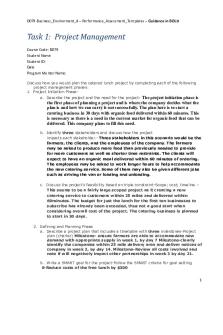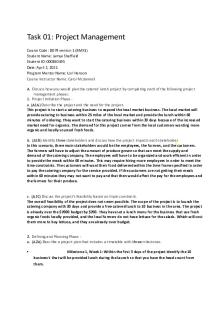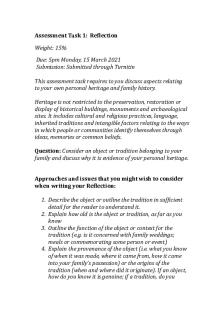C105 TASK 1 WGU.edu PDF

| Title | C105 TASK 1 WGU.edu |
|---|---|
| Course | Instructional Strategies and Technologies for Elementary Learners with Mild to Moderate Exceptionalities |
| Institution | Western Governors University |
| Pages | 7 |
| File Size | 254.8 KB |
| File Type | |
| Total Downloads | 4 |
| Total Views | 149 |
Summary
Instructional Strategies and Technologies for Elementary Learners with Mild to Moderate Exceptionalities D006...
Description
Paige Botson C105 Elementary Visual and Performing Arts Methods. September 14th, 2021.
A. Math & Visual Arts Visual Art Standard: OH.1.5.PR.B. Use selected art and design elements and principles to explore ideas, feelings, and relationships. Explore a range of art concepts and artworks and construct meaning about the works. (OHDE, 2012). Math Standard: OH. 1.G.1 Distinguish between defining attributes, e.g., triangles are closed and three-sided, versus non-defining attributes, e.g., color, orientation, overall size; build and draw shapes that possess defining attributes. (OHDE,2017). A3. Students will begin learning about many geometrical shapes such as rectangles, rhombuses, and squares. Students will also be able to distinguish between these shapes defining attributes such as the number of sides each shape has or how their defined by their measurements. Along with shapes non-defining attributes such as color or overall size. Students will then explore, build, and draw these shapes with their defining attributes. Then use this information to create art pieces that incorporate these shapes and design elements and principles into a visual art piece. The teacher will assist students in distinguishing geometrical shapes by helping them understand shapes through experiences. For example, using common objects around the classrooms to help the students distinguish different shapes, such as using the classroom door as an example of a rectangle. A3a. A work of art that will be used in the activity will be the Wassily Kandinsky 1923 Composition VIII
Wassily Kandinsky. Composition VIII, (1923). (2021).
A3b. Composition VIII supports this learning activity as it will allow the first graders to see how these geometrical shapes can be incorporated into art The teacher will give the whole class opportunities to raise their hands and identify any specific shapes in the visual art piece that were previously discussed in the lesson. After identifying shapes and discussing the piece, students will be instructed to work in pairs to create art pieces. Choosing from a variety of mediums and materials such as paint, chalk, markers, paper, and glue. Students will be able to offer and receive constructive feedback in with their partners. Along with assistance from the teacher if needed as he or she walks around the class observing and helping other students. After students are completed with their art pieces, they will take turns presenting their piece to the class and describe which shapes they incorporated into their art piece and describe why they chose their specific materials to explore the relationship of the shapes in their art piece. Students will be scored using a rubric during their presentation of their artwork
Impey, M. Rubrics Galore! A4. The activity discussed effectively integrated the visual arts standard and the academic standard into one cohesive learning experience by integrating both the math standard by teaching students to distinguish between these shapes defining attributes such as the number of sides each shape has or how their defined by their measurements. Along with shapes non-defining attributes such as color or overall size. Along with integrating the visual arts state standard by using selected shapes and design elements and principles to explore ideas and relationships between shapes. Students are also able to explore a range of art concepts and artworks and construct meaning about the works. This can be done by having students evaluate each other’s projects and Composition VIII and then use a medium of their choice to explore and create their own concepts with the new information they’ve learned in order to complete their own visual art piece.
B. English Language Arts/ Theater English L.A. Standard: RL.1.3 Describe characters, settings, and major events in a story, using key details RL.1.9 Compare and contrast the adventures and experiences of characters in stories.
(OHDE, 2017). Theater Standard: OH.1.1.PR. Retell or dramatize stories, myths and fairy tales from various time periods and cultures. OH.1.1. CE Retell the beginning, middle and ending of stories in proper sequence. OH.1.2. CE Identify the characters, time, place, and major events in stories. (OHDE, 2012). Create an integrated drama/theater activity for the selected elementary grade level by doing the following: B3. A learning activity that integrates the identified standards begins with the teacher reading aloud the story Little Red Riding Hood by Gabby Goldsack to the entire class. After listening to the story, students will be put in heterogenous groups. The teacher will then have the students document key events and details of the story while using key details from the story to fill out the pleasing plot graphic organizer as a group. Following this activity, the students will be asked to work together in their groups and use their graphic organizer to assign roles and perform the story of Little Red Riding Hood, in front of the class.
B3a. Little Red Riding Hood by Gabby Goldsack.
Goldsack, G., Kolanovic D. Little Red Riding Hood. (June 2012). Paragon Inc. B3b. The selected work of art supports the learning activity as it provides a visual to help them comprehend the main point of the story and identify the main points. This allows the students to accurately comprehend the story and act it out themselves B4. The activity supports the drama theater standard as it allows students to retell or dramatize stories retell the beginning, middle and ending of stories in proper sequence and identify the characters, time, place, and major events in stories. The activity also meets the language arts standard by describing characters, settings, and major events in a story, using key details. Both standards are met with the students use of the graphic organizer and the dramatization of the
story by the students which helps solidify comprehension of the sequence of events that take place in the story. C. Dance/ Science Dance Standard: OH.1.7.PE. Describe different ways that movements shaped into dance depict feelings and emotions OH.1. 5.RE Share their ideas about dances they observe and tell what they think the work was about (OHDE, 2012). Science Standard: OH.1.PS.1: Properties of objects and materials can change. (OHDE, 2019). C3. A learning activity that integrates the identified standards from part C1 begins with the teacher beginning a demonstration on a solid a liquid and a gas. This is shown using an ice cube, a glass of water and a humidifier. They will then listen to Matter Chatter a song about solids, liquids, and gases. After listening to the song, the teacher will ask students how each phase of matter moves. “How does a liquid move? Is it flowing or racing around?” and “How does a gas move? Does it float through the air gently?”. The teacher and students will then come to an agreement on how they think each type of matter moves. Next the teacher will match students in heterogenous groups of 3. One student in each group will perform as a type of matter. In these groups students will demonstrate in front of the class how the states of matter move in a way that they can express. Other students in the class will raise their hands and try to guess which student is demonstrating what form of matter, based on how the student performing in moving. C3a. Matter Chatter by Harry Kindergarten Music (2014). C3b. The selected work of art supports the learning activity and is appropriate for the identified grade level as it demonstrates and explains the parts of matter to the 1st graders in developmentally appropriate vocabulary and gives them a visual of each different type of matter with real world examples so that the students and activate and build upon prior knowledge. C4. This activity effectively integrates the Ohio dance and science standards by having students display different ways that movements shaped into dance depict feelings and emotions by relating each of their dances to a type of matter and how it moves. Students are then able to share their ideas about dances they observe and tell what they think the work was about based off of their peers’ performances. With the Matter Chatter song and physically moving their bodies, students are better able to understand the different types of matter which effectively integrates the science standards and helps build together one cohesive learning experience. D. Music and Social Studies Music Standards: OH.1.3.CE. Listen to and identify music of various and contrasting styles, composers, periods, and cultures. (OHDE, 2012).
Social Studies Standards: OH.1.8.HS. Cultures Develop in different ways, in part through the influence of the physical environment (OHDE,2019). D3. An activity that integrated the two identified standards above starts with the teacher asking students if they know where their families and ancestors are from, and if they see distinct cultures in their homes different from what some of their peers may experience. Such as holidays and traditions. Next the teacher will project the A Musical Journey video. This video gives students a basic understanding that different countries and cultures around the world have different types of music. Some of which may be familiar to some students. Students will then be instructed to create a poster of common culture and traditions that they may experience in their families. They will each find one song from their culture to include and to show the rest of the class. The teacher will then have a map with pins that have each of the students’ names on it. After the student is done showing their work and song to the class. The teacher will place their pin in the region that their chosen culture stems from. This allows all students to see where certain music pieces come from throughout the world. The teacher will also spark a discussion about which cultures have similar music. D3a. Song Library. A Musical Journey. (2015).
D3b. The selected work of art supports the learning activity as it takes students around the world to discover the music, instruments and sounds of many countries and cultures. Students can then use this information when creating their posters and finding appropriate music for their project. D4. The activity effectively integrates the music standard and the academic standard from above into one cohesive learning experience by integrating social studies by demonstrating how cultures develop and their music. The Ohio music standard is met by students listening to and identifying music of various and contrasting styles, and cultures. This is done by the students presenting their projects to the rest of the class and students comparing the different music styles in different cultures.
E. Ohio Department of Education. Ohio Learning Standards: Visual Arts Grades K-12: Producing and Performing. (2012). Pg. 1. CS.1, Retrieved on September 6th, 2021. From http://education.ohio.gov/getattachment/Topics/Learning-in-Ohio/Fine-Arts/Fine-ArtsStandards/Ohio-Visual-Art-Standards-2012.pdf.aspx?lang=en-US Ohio Department of Education. Ohio Learning Standards: Mathematics. (2017). Pg.12. Section 1.G. Retrieved on September 6th, 2021. from http://education.ohio.gov/getattachment/Topics/Learning-in-Ohio/Mathematics/Ohio-s-LearningStandards-in-Mathematics/MATH-Standards-2017.pdf.aspx?lang=en-US Wassily Kandinsky. Composition VIII, (1923). (2021). Retrieved on September 9th, 2021, from https://www.wassilykandinsky.net/work-50.php Ohio Department of Education. Ohio’s Learning Standards: English Language Arts. (2017). Pg. 14. Retrieved on September 6th, 2021. From http://education.ohio.gov/getattachment/Topics/Learning-in-Ohio/English-Language-Art/EnglishLanguage-Arts-Standards/ELA-Learning-Standards-2017.pdf.aspx?lang=en-US Ohio Department of Education. Ohio’s Learning Standards: Drama and Theater. (2012). Pg.1. Retrieved on September 6, 2021. From http://education.ohio.gov/getattachment/Topics/Learning-in-Ohio/Fine-Arts/Fine-ArtsStandards/Ohio-Drama_Theatre-Standards-2012.pdf.aspx?lang=en-US Goldsack, G., Kolanovic D. Little Red Riding Hood. (June 2012). Paragon Inc. Ohio Department of Education. Ohio State Standards: Dance Standards. (2012). Grades k-2. Pg.1. Retrieved on September 6, 2021. From http://education.ohio.gov/getattachment/Topics/Learning-in-Ohio/Fine-Arts/Fine-ArtsStandards/Ohio-Dance-Standards-2012.pdf.aspx?lang=en-US Ohio Department of Education. Ohio Learning Standards and Model Curriculum: Science. (2019). Pg. 40. Retrieved on September 6, 2021. From http://education.ohio.gov/getattachment/Topics/Learning-in-Ohio/Science/Ohios-LearningStandards-and-MC/SciFinalStandardsMC060719.pdf.aspx?lang=en-US Matter Chatter by Harry Kindergarten Music (2014). Retrieved on September 12, 2021, from https://www.youtube.com/watch?v=C33WdI64FiY Ohio Department of Education. Ohio Learning Standards: Music. (2012). Pg. 1. Retrieved on September 6, 2021. From http://education.ohio.gov/getattachment/Topics/Learning-inOhio/Fine-Arts/Fine-Arts-Standards/Ohio-Music-Standards-2012.pdf.aspx?lang=en-US Ohio Department of Education. Ohio’s Learning Standards: Social Studies. (2019). Pg. 12. Retrieved on September 6, 2021. From http://education.ohio.gov/getattachment/Topics/Learning-in-Ohio/Social-Studies/Ohio-sLearning-Standards-for-Social-Studies/SSFinalStandards01019.pdf.aspx?lang=en-US
Impey, M. Rubrics Galore! (2012). Retrieved 9 September 2021, from http://artroom104.blogspot.com/2012/10/rubrics-galore.html Song Library. A Musical Journey. (2015). Retrieved 14 September 2021, from https://www.youtube.com/watch?v=iNv6XvRJQS4...
Similar Free PDFs

C105 TASK 1 WGU.edu
- 7 Pages

Task 1 - Complete Task 1 for C105
- 10 Pages

PCE Task 1 - Task 1
- 2 Pages

Task 1 - SUS101 Task 1
- 2 Pages

Qht1 task 1 - Task 1
- 3 Pages

QBM1 Task 1 - Task 1
- 5 Pages

C365 - Task 1 - Task 1
- 4 Pages

Task 1 - C226 Task 1
- 11 Pages

C304 Task 1 - TASK 1
- 16 Pages

DIT1 TASK 1 - Task 1
- 4 Pages

D078 Task 1 - task 1
- 2 Pages

Task d079 copy - Task 1
- 3 Pages

HMc Daniel Task 1 - Task 1
- 9 Pages
Popular Institutions
- Tinajero National High School - Annex
- Politeknik Caltex Riau
- Yokohama City University
- SGT University
- University of Al-Qadisiyah
- Divine Word College of Vigan
- Techniek College Rotterdam
- Universidade de Santiago
- Universiti Teknologi MARA Cawangan Johor Kampus Pasir Gudang
- Poltekkes Kemenkes Yogyakarta
- Baguio City National High School
- Colegio san marcos
- preparatoria uno
- Centro de Bachillerato Tecnológico Industrial y de Servicios No. 107
- Dalian Maritime University
- Quang Trung Secondary School
- Colegio Tecnológico en Informática
- Corporación Regional de Educación Superior
- Grupo CEDVA
- Dar Al Uloom University
- Centro de Estudios Preuniversitarios de la Universidad Nacional de Ingeniería
- 上智大学
- Aakash International School, Nuna Majara
- San Felipe Neri Catholic School
- Kang Chiao International School - New Taipei City
- Misamis Occidental National High School
- Institución Educativa Escuela Normal Juan Ladrilleros
- Kolehiyo ng Pantukan
- Batanes State College
- Instituto Continental
- Sekolah Menengah Kejuruan Kesehatan Kaltara (Tarakan)
- Colegio de La Inmaculada Concepcion - Cebu


